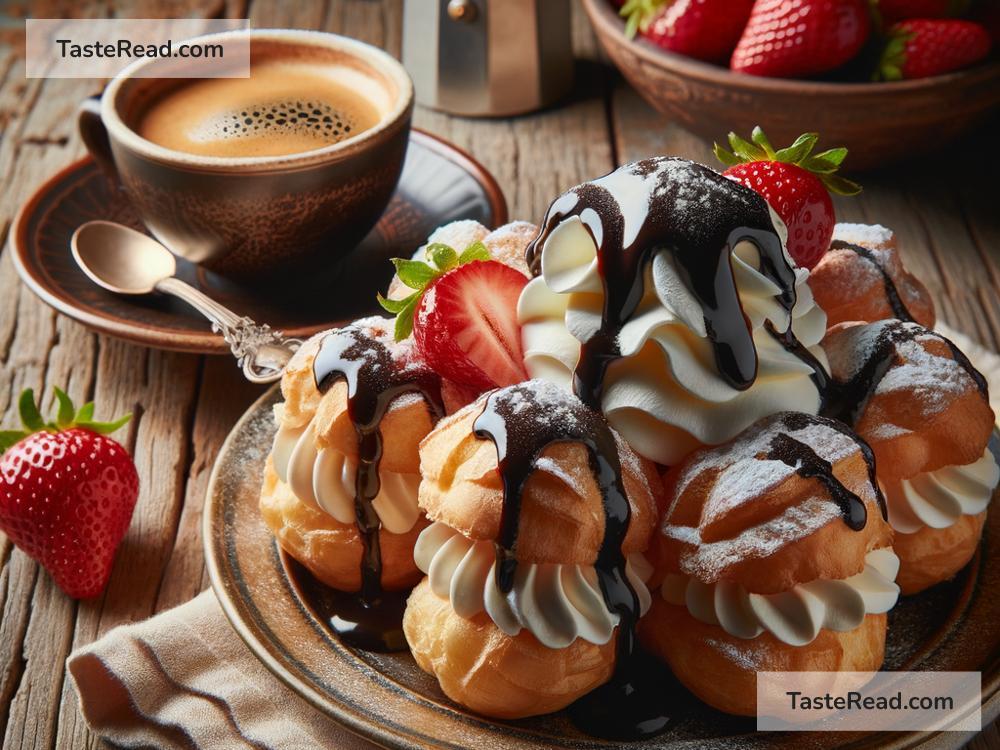The Story of the French Profiterole: A Sweet Treat Through the Ages
The profiterole is a beloved dessert that has been enjoyed for centuries. Soft, airy, and filled with cream or custard, these delightful little pastries have a fascinating history that spans different countries, famous chefs, and festive dining tables. Let’s take a journey to uncover the story behind this tasty treat and discover how it became the dessert we know and love today.
The Origins: From Choux Pastry to Profiterole
The story of the profiterole begins with choux pastry (or pâte à choux in French), the delicate dough used to create the pastry shell. Choux pastry is unique because it puffs up beautifully in the oven, forming hollow pockets perfect for filling. While it’s now considered a French specialty, the choux pastry wasn’t invented by the French—it can actually be traced back to Italy.
In the 16th century, an Italian chef named Panterelli created a special dough recipe when serving in the court of French royalty. Catherine de Medici, the Queen of France who was originally from Italy, brought Panterelli to work in her kitchens. Over time, his dough recipe evolved, becoming lighter and better suited for baking delicate pastries. This new method later became known as choux pastry. The name “choux” means “cabbage” in French, likely because the finished pastry somewhat resembles a tiny, round cabbage.
The Birth of the Profiterole
Though choux pastry became a staple in French baking, the profiterole as we know it today did not appear until much later. Early versions of the profiterole were simple—small balls of baked dough that were often served plain or with savory fillings, such as cheese or meat.
In the 17th century, French chefs began experimenting with sweet versions of choux pastries. It was during this time that they began filling profiteroles with custards, creams, and other sweet mixtures. These filled pastries then became popular as desserts, cementing their place in French cuisine.
The Chocolate Revolution
By the 19th century, the profiterole had transformed into a dish fit for royalty. It was during this time that chefs began serving profiteroles with chocolate sauce—a revolutionary idea that made the dessert even more indulgent and irresistible.
Carême, one of France’s most famous pastry chefs, played a key role in elevating the profiterole. Known as the “King of Chefs and Chef of Kings,” Carême specialized in elaborate and impressive desserts. He often used choux pastry to create profiteroles and other intricate creations, inspiring future generations of pastry chefs. Thanks to Carême and others like him, the profiterole grew in popularity and became a beloved treat across France.
A Dessert for All Occasions
Throughout the centuries, the profiterole has maintained its reputation as a versatile dessert. It is often served at weddings, holiday celebrations, and family gatherings. Whether piled high on a platter, artfully drizzled with chocolate, or transformed into a stunning croquembouche—a towering cone of profiteroles held together with caramel—this dessert has found its place in the hearts of pastry lovers everywhere.
Though the traditional version includes choux pastry shells filled with vanilla cream or custard and topped with chocolate sauce, profiteroles have been reinvented in countless ways. Today, you can find profiteroles filled with ice cream, flavored creams, or even fruit compotes. Some modern chefs take the pastry to new heights by adding unique toppings or creating savory profiteroles filled with cheese spreads and mousses.
Why Do We Love Profiteroles So Much?
Part of the charm of profiteroles lies in their simplicity. Though they may look impressive, they are made with just a few basic ingredients: flour, water, butter, and eggs for the pastry; cream for the filling; and chocolate for the topping. These ingredients come together to create something magical—a dessert that is light yet indulgent, creamy yet not too overwhelming. Their bite-sized nature also makes them fun to eat and share.
Another reason for their lasting popularity is their versatility. Whether you’re enjoying two or three profiteroles for dessert after dinner or admiring a beautifully constructed croquembouche at a wedding, these delightful pastries can elevate any occasion. They’re a sweet treat that brings people together and adds a touch of joy to any event.
Profiteroles Around the World
Though profiteroles are traditionally French, they’ve traveled far beyond the borders of France. In Italy, they’re often associated with cream puffs, which are similar in concept. In the United States, profiteroles have inspired desserts such as the Boston cream puff and other variations. Around the globe, chefs have adapted the basic concept to fit local tastes and flavors, making profiteroles a truly international dessert.
Conclusion: A Timeless Classic
The story of the profiterole is one of transformation, creativity, and simple pleasures. From its humble beginnings in Italy to its celebrated role as a French classic, this dessert has delighted generations with its airy puff shells and creamy fillings. Whether you enjoy them topped with chocolate, filled with ice cream, or served as part of a grand feast, profiteroles are a reminder of how food can bring happiness to our lives.
So next time you bite into a profiterole, take a moment to appreciate its rich history. You’re not just enjoying a sweet treat—you’re savoring centuries of culinary tradition!


